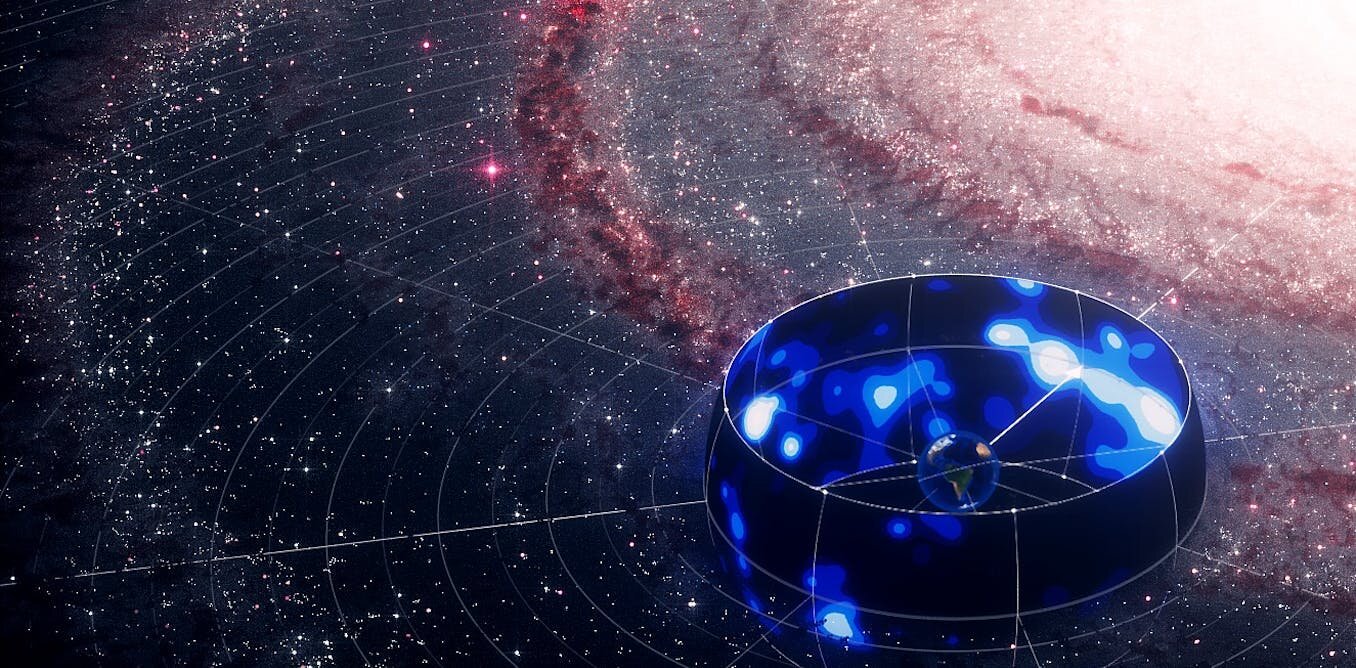A Neutrino Portrait of Our Galaxy Reveals High-Energy Particles from Within the Milky Way
Credit: IceCube Collaboration/Science Communication Lab for CRC 1491
Our Milky Way galaxy is a breathtaking sight in the night sky, visible to the naked eye as a shimmering band of stars extending from horizon to horizon. Recently, the IceCube Neutrino Observatory in Antarctica has captured an image of the Milky Way using neutrinos, which are elusive and ghost-like messengers from the depths of space. The IceCube Collaboration, an international consortium of over 350 scientists, has published their research on June 29 in the prestigious journal Science, presenting evidence of high-energy neutrino emissions originating from our very own galaxy.
Although the exact sources of these particles within the Milky Way remain unknown, this groundbreaking discovery brings us closer to understanding the extreme environments within our galactic neighborhood. Neutrinos provide astronomers with a unique perspective on the universe because they can traverse vast distances unimpeded by any other form of radiation or particles. Thus, they offer a window into the turbulent cosmic environments that give rise to another class of particles called cosmic rays.
Cosmic rays are highly energetic particles that permeate the cosmos, but their origins have proven elusive thus far. Due to their electrical charge, cosmic rays are deflected by magnetic fields, making it nearly impossible to trace their paths back to their sources. However, the same extreme environments that generate cosmic rays also produce neutrinos. Unlike cosmic rays, neutrinos are electrically neutral, allowing them to travel in straight lines. By detecting the trajectory of neutrinos reaching Earth, scientists can trace their origins back to their birthplaces.
The detection of neutrinos, however, is no easy feat. Located near the South Pole, the IceCube Neutrino Observatory utilizes more than 5,000 light sensors spread across a cubic kilometer of pristine Antarctic ice to identify signs of high-energy neutrinos originating from both within and beyond our galaxy. Countless neutrinos stream through our planet every moment, but only a tiny fraction of them actually interact with matter during their passage. Each interaction produces a faint flash of light, which the IceCube sensors diligently detect. The amount and pattern of this light can be used to determine the direction and energy of the neutrinos.
The IceCube Observatory has previously detected high-energy neutrinos originating from outside the Milky Way. However, isolating the lower-energy neutrinos emanating from within our own galaxy has proven more challenging. This difficulty arises from the fact that some of the observed flashes detected by IceCube can be attributed to cosmic rays colliding with Earth’s atmosphere, creating neutrinos and other particles known as muons. To filter out these unwanted signals, the IceCube researchers have developed methods to differentiate atmospheric particles from those originating beyond our planet by analyzing the distinct light patterns they generate in the ice. This filtering process has enhanced IceCube’s sensitivity to astrophysical neutrinos.
The groundbreaking achievement of capturing a neutrino image of the Milky Way was made possible by employing machine-learning techniques to improve the identification of light cascades produced by neutrinos, as well as determining their direction and energy. With this newfound ability, scientists are inching closer to solving the mystery of cosmic rays and the locations of the most powerful cosmic accelerators within our galaxy.
Although the exact cosmic ray accelerators in the Milky Way have yet to be pinpointed, the recent IceCube analysis has provided evidence of neutrinos originating from broad regions of our galaxy. However, individual sources have not been discerned. To address this knowledge gap, our team at the University of Canterbury in New Zealand and the University of Adelaide in Australia is developing models to predict the neutrino signal near potential particle accelerators. This will allow us to precisely target our search for neutrino sources within the IceCube data.
Undergraduate student Rhia Hewett and Ph.D. student Ryan Burley from our team are focusing on pairs of accelerator candidates and molecular dust clouds. They aim to estimate the flux of neutrinos generated by cosmic rays interacting within these clouds after traveling from the accelerators. By utilizing these estimations, we can conduct a more targeted analysis of IceCube data to identify the sources of neutrino emissions. We believe this approach holds the key to unveiling the secrets of the most energetic processes occurring in our beloved Milky Way.
More information: et al, Observation of high-energy neutrinos from the Galactic plane, Science (2023). DOI: 10.1126/science.adc9818
Provided by The Conversation
This article is republished from The Conversation under a Creative Commons license.
Read the original article.
Citation: A neutrino portrait of our galaxy reveals high-energy particles from within the Milky Way (2023, July 1) retrieved 1 July 2023 from <a href="https://phys.org/news/2023-06-neutrino-portrait-galaxy-reveals-high-energy.html">https://phys.org/news/2023-06-neutrino-portrait-galaxy-reveals-high-energy.html</a>
This document is subject to copyright. Apart from any fair dealing for the purpose of private study or research, no part may be reproduced without the written permission. The content is provided for information purposes only.
Denial of responsibility! SamacharCentrl is an automatic aggregator of Global media. In each content, the hyperlink to the primary source is specified. All trademarks belong to their rightful owners, and all materials to their authors. For any complaint, please reach us at – [email protected]. We will take necessary action within 24 hours.

Shambhu Kumar is a science communicator, making complex scientific topics accessible to all. His articles explore breakthroughs in various scientific disciplines, from space exploration to cutting-edge research.


